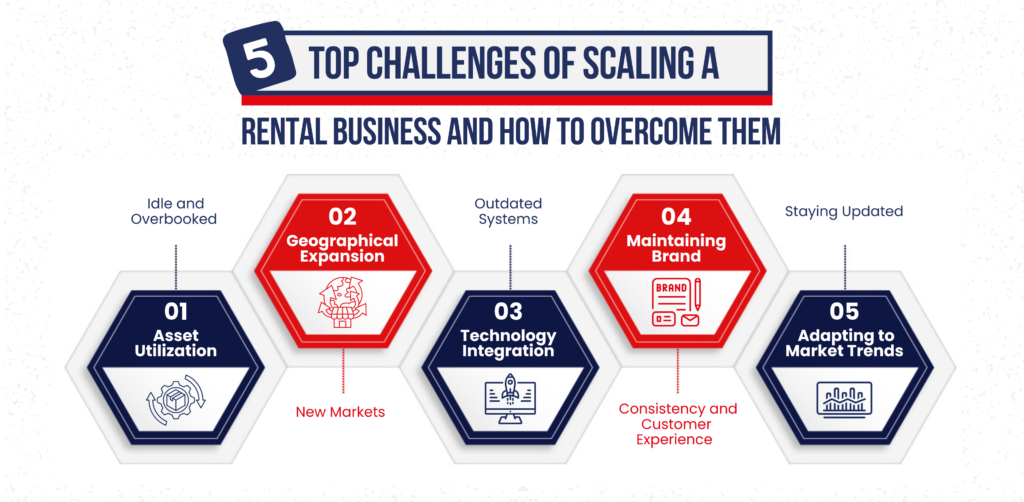Scaling a Rental Business: Top 5 Challenges and Solutions

Growing a rental business is exciting, but it comes with its own set of challenges. Managing assets, expanding to new locations, and keeping operations smooth can be tough. To grow successfully, businesses need smart strategies and the right rental management solution.
With the rental market expected to reach $280.13 billion by 2030, growing at 6.12 percent annually, the opportunity is huge. But so are the hurdles. Here are five key problems rental businesses face when scaling, and practical solutions to overcome them.
1. Managing Assets: Avoiding Idle Time and Overbooking
The Problem:
If assets sit unused, it wastes your investments. But if you overbook, customers get frustrated. Finding the right balance is key.
The Solution:
- Use software with smart analytics to track how often assets are rented and how much money it makes.
- Identify assets that are rarely rented and consider selling them or adjusting prices.
- Adjust pricing based on demand—lower prices during slow seasons and raise them when demand is high.
Example:
A business that keeps at least 72 percent of its assets rented makes the most profit. If usage drops, it might be time to sell unused assets or move them to locations where demand is higher.
2. Expanding to New Locations: Keeping Operations Organized.
The Problem:
Opening in new locations means dealing with different rules, currencies, and customer demands. If operations are not well managed, it can create confusion.
The Solution:
- Use a cloud-based rental management system to manage all locations from one place.
- Automated tasks like currency conversion, tax calculations, and regional reporting.
- Keep rental processes the same across locations to ensure consistency.
Example:
A company with branches in Tokyo and Texas can use the same software to track rentals, pricing, and inventory, making expansion smoother.
3. Upgrading Technology: Avoiding System Failures and Inefficiencies
The Problem:
Old or disconnected systems slow down business operations. These are often legacy systems that rely on old tech stack. Many companies lose up to 30 percent of their efficiency because of outdated technology.
The Solution:
- Use an all-in-one rental management system to handle inventory, maintenance, and customer relationships in one place.
- Add GPS and sensors to asset for real-time tracking and automated maintenance alerts.
- Automate invoicing and contracts to reduce paperwork and errors.
Example:
By using real-time tracking, a rental company reduced downtime by 15 percent and cut repair costs by 20 percent, improving efficiency and customer satisfaction.
4. Keeping Service Consistent: Maintaining Brand Trust
The Problem:
If service quality is different across locations, customers lose trust. Inconsistencies in pricing, rental agreements, or customer communication can harm the business.
The Solution:
- Automate rental agreements, invoicing, and inspections to ensure uniform service.
- Set clear guidelines for customer interactions to maintain a consistent brand experience.
- Use automated reminders for returns and maintenance to reduce late fees and improve service.
Example:
A company that set up automatic return reminders saw a 25 percent improvement in returns on time, leading to better customer satisfaction and fewer disputes.
5. Adapting to Market Changes: Staying Ahead of Competitors
The Problem:
Demand for rental asset changes due to seasonality, industry trends, or unexpected events. If a company does not adjust quickly, it can lose revenue.
The Solution:
- Track key performance indicators (KPIs) like rental rates and asset availability.
- Use data to predict demand changes and adjust pricing or inventory.
- Move high-demand assets to busy locations and reduce stock in slow areas.
Example:
During a construction boom, businesses using real-time data adjusted their pricing and moved assets to high-demand areas, increasing profits without adding more inventory.
Scaling Smart: Why the Right Rental Management System Matters
Growing a rental business is easier with the right tools. Companies that use advanced rental management systems can:
- Manage multiple locations from one platform.
- Automate workflows to reduce errors and improve efficiency.
- Use AI and IoT technology for real-time decision-making.
Conclusion
Scaling a rental business is not just about getting bigger—it is about getting smarter. Companies that use technology to improve efficiency, predict demand, and keep service consistent will grow faster and stay ahead of competitors.
With the right strategy and tools, rental businesses can expand with confidence, deliver better customer experiences, and increase growth and profitability.






